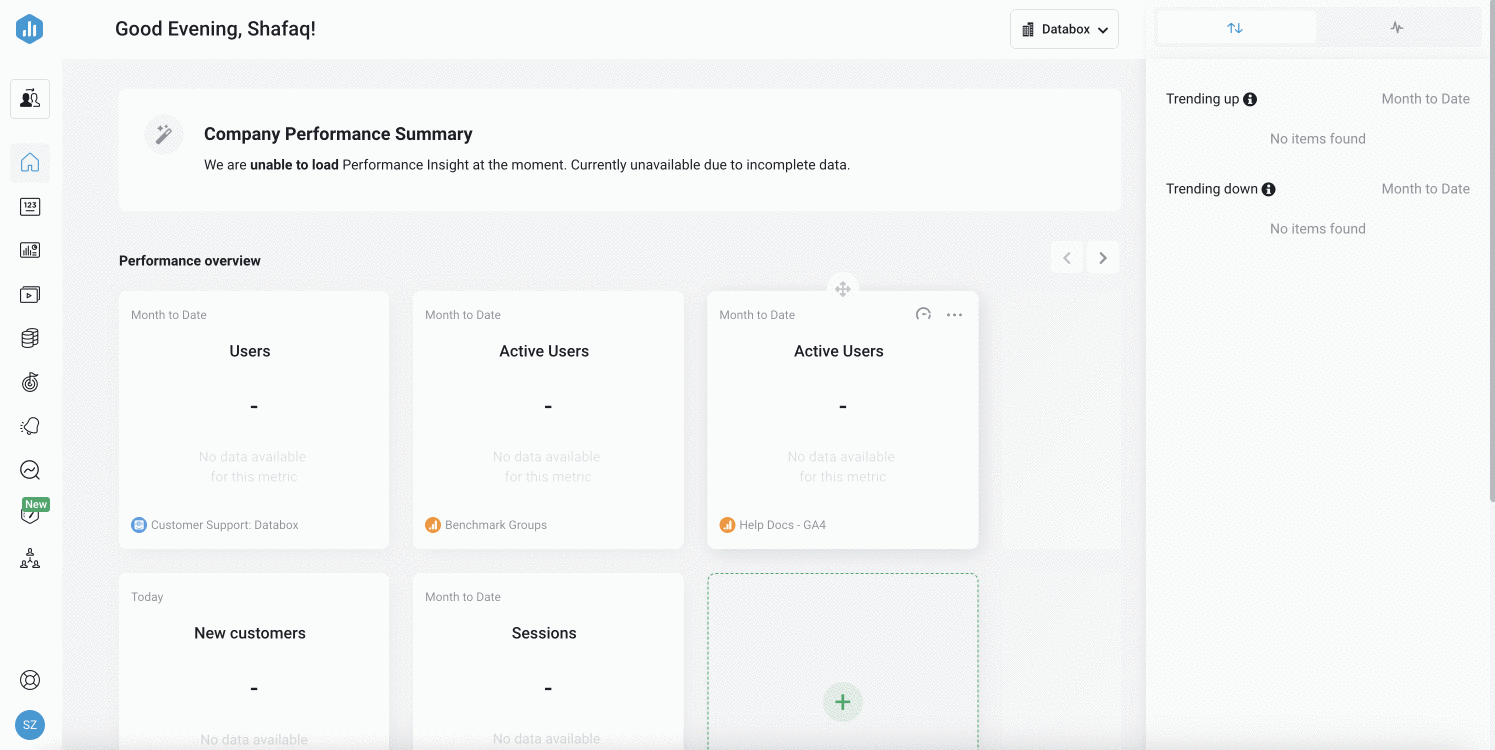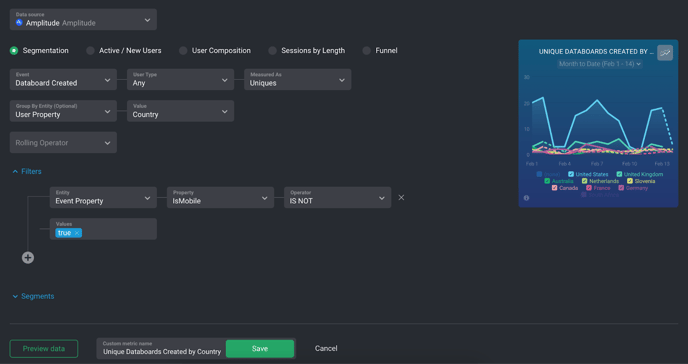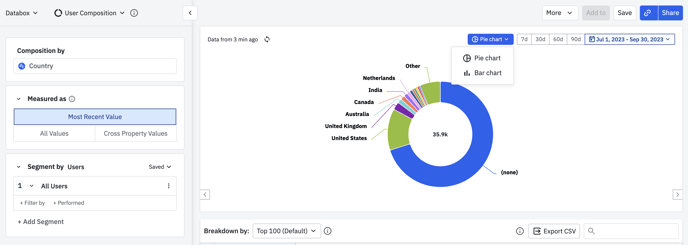Overview: Metric Builder for Amplitude (Segmentation)
HOW TO
- Access the Metric Builder for Amplitude (Segmentation)
- Use the Metric Builder for Amplitude (Segmentation)
- Create a Custom Amplitude Segmentation Metric [Example]
- Add a Custom Amplitude Segmentation Metric to a Databoard
- Additional Information
How to access the Metric Builder for Amplitude (Segmentation)

Navigate to Metrics > Custom Metrics to access the Metric Builder. Click the green + New Custom Metric button and select your connected Amplitude Account from the Data Source drop-down list. Select the Segmentation radio button
Metric Builder is available on Professional and higher plans. Request a trial of Metric Builder by following these steps.
How to use the Metric Builder for Amplitude (Segmentation)

- A) Data Source: This is the Amplitude Data Source that the Custom Metric is syncing data from.
- B) Event: Select an Event from your connected Amplitude Data Source. The events are user specific and will reflect the Events created in your Amplitude Account.
When you select an event, the following fields will appear progressively as you select an option for each field:- User Type: Select your User type for the Event. You can select "Any" or "Active".
- Measured As: Select how you want that measured as.
- Group By Entity (Optional):This field enables you to further categorize selected event based on a chosen grouping criterion. You can either group your data by “Event” properties or “User” properties. While Event properties are event specific, User properties are common to all events. By selecting a specific group, you can organize and analyze user data according to your preferences or segmentation criteria (for example, you can group users by Country).
- Value: Select a value from the dropdown you want your data to be grouped by (i.e. Country).
- D) Rolling Operator (Optional): Select your desired operator (Rolling Average or Rolling Window). While Rolling Window is a feature that allows users to analyze data within a specified time frame that continuously updates as time progresses, Rolling Average refers to a statistical calculation that smooths out fluctuations in data over time by averaging values within a moving window.
- Value: Enter a numerical value for the Rolling setup.
-
D) Entity (Optional): Select your Filters by using the Entity Filter. The Entity filters restrict the data that gets included in the Custom Metric. All data that is returned is tested against the Entity Filter(s). Multiple Filters can be combined using AND boolean logic.If the data synced from the Metric fields meet the Filter specifications, the data is retained and included in the Custom Metric value. If the data synced from the Metric fields don't meet the Filter specifications, the data is excluded from the Custom Metric value. When you select an Entity filter, the following fields will appear progressively as you select an option for each field:
- Property: Select the Property for your Entity filter.
- Operator: Select the Operator from the drop-down list
- Values: Enter a Value for your Entity filter setup.
-
D) Property (Optional): Select your Segments by using the Property Filter. The Property filters restrict the data that gets included in the Custom Metric. All data that is returned is tested against the Property Filter(s). Multiple Filters can be combined using AND boolean logic.If the data synced from the Metric fields meet the Filter specifications, the data is retained and included in the Custom Metric value. If the data synced from the Metric fields don't meet the Filter specifications, the data is excluded from the Custom Metric value. When you select a Property filter, the following fields will appear progressively as you select an option for each field:
- Operator: Select the Operator for the Property.
- Values: Enter a Value for your Property filter setup.
- E) Preview data: After clicking Preview data, a Data Preview of the Custom Metric will be displayed. Daily Metric values are displayed in this section, along with the total Metric values for the Date Range in bold at the bottom. You can view the Data Preview for different Date Ranges by clicking on the drop-down list at the top of the Data Preview.
- F) Custom Metric Name: Enter a name for your Custom Metric. This Custom Metric name will be available in the Designer after saving.
-
G) Save: Save your Custom Metric.
How to create a Custom Amplitude Segmentation Metric [Example]
In this example, we'll create a Custom Metric to report on Unique Databoards tracked in the Amplitude Account, split up based on Country. 
- Navigate to Metrics > Custom Metrics
- Click the green + New Custom Metric button
- Select the appropriate Amplitude Data Source
- Select the Segmentation radio button.
- Select an Event from the Event drop-down list. The Events are user specific as they reflect the events created in your Amplitude Account. Once you have selected the Event, the other fields will appear progressively as you select an option for each field. For this example, we will select the Event as Databoard Created, from the User Type drop-down we will select Any and from the Measured as drop-down, we will select Uniques.
- We'll select User Property from the Group By Entity (Optional) drop-down list, and we'll select Country from the Value's drop-down list so that the values returned are split up based on Country.
- Next, select the Entity Filter to further filter our Data. We'll select Event Property from the Entity drop-down list. Once we have selected the Entity, the other fields will appear progressively as we select an option for each field. We'll select IsMobile as the Property, IS Not from the Operator and True from the Value drop-down lists.
- We don't need to further filter the data, so we will not apply any Segment filters.
- In order to accurately explain what this Custom Metric is reporting on, we'll name the Custom Metric "Unique Databoards Created by Country"
- Click Preview data to generate a Data Preview of the Custom Metric.
- Once we confirm that these are the results we're looking for, we'll click Save to save the Custom Metric.
How to add a Custom Amplitude Segmentation Metric to a Databoard
Learn how to add a Custom Metric to a Databoard here.
Additional Information
Metric Considerations
The following considerations are due to API/technical limitations and the availability of data:
- The Data Preview is limited to display a maximum of 20 Dimensions per Date Range for Dimensional Metrics. Dimensions will be sorted by descending value, therefore the 20 Dimensions with the highest total values will be displayed in the Data Preview for each Date Range.
- Last X days on the Amplitude UI corresponds to last X+1 days, including today on Databox UI. For example, If the last 2 days are selected on Amplitude, the last 3 days including today must be selected on Databox.
- The "Total Users" Metric corresponds to the “Most Recent” values in your Amplitude Account. This is selected as default in your Amplitude Account.

- The Cumulative toggle can be enabled for the Custom Metrics, but this can lead to data discrepancies as none of the Metrics support this functionality due to technical limitation.
Granularity Restrictions
- For the Basic Metrics "Active Users", "New Users", "Average Session Length" and "Average Sessions Per User" and the Custom Metrics that are created by using the Amplitude Metric Builder (Segmentation, Active / New Users and Funnel), only Daily, Weekly and Monthly granularity is supported.
- Weekly granulation is supported, but it can cause data discrepancies if you have the first day of the week setting in your Databox Account to a different day in comparison to the first day of the week set in your Amplitude Account.
- Due to API limitations, Quarterly, Yearly and All Time granularity is not supported for these Metrics. This may affect visualization options for Charts in Databox. Learn more about Granularity here.
- For the Basic Metrics "Total Users by Country", "Total Users by Region", "Sessions by Length in Seconds" and the Custom Metrics that are created by using the Amplitude Metric Builder (User Composition and Sessions by Length), Daily, Weekly, Monthly. Quarterly, Yearly and All time granularity is supported.
- For Daily granularity, the maximum data we’re able to fetch is 60 days in the past.
- For Weekly granularity, the maximum data we're able to fetch is 6 months in the past.